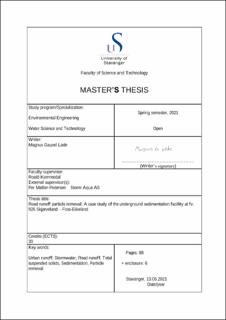| dc.description.abstract | With increasing urbanization, the effect of urban runoff on vulnerable recipients increases. Commonly, open wet ponds have been used for treatment of road surface runoff. With increasing urbanization and a focus on reducing the impact new development has on nature, more area-conservative solutions are needed. This thesis focuses on and studies an underground sedimentation facility for the treatment of road surface runoff water. The main focus of the thesis is examining the TSS removal efficiency of the facility, determining what central tendency measure is the most accurate, and finally comparing the facility efficiency to other methods and to legal requirements. Secondary, a theory of short circuit was examined and any effect dividing walls in the sedimentation pipes might have on the efficiency. Sampling was done from January 2021 until early May 2021, whenever sufficient precipitation events occurred. An issue with the measurement instrument in addition to a limited number of events lead to the number of events sampled being lower than wished, but still enough to draw a conclusion. The overall TSS removal efficiency of the sedimentation pipes was concluded to be 65% - 68%. Based on other studies, by including the gully pots before the facility it is expected to reach a TSS removal efficiency of at least 80%. Both site-mean concentration and total median value is shown to be useful for determining the particle load to the facility. Site mean concentration is however recommended due to the varying load and length of runoff events.
The runoff showed first flush tendencies when expected and the facility showed effectiveness in reducing extreme measurements.
No significant short circuit adding an increased strain on one of the pipes was found. However more sampling at different flow intensities is recommended to draw a final conclusion.
The facility is concluded to be comparable in efficiency to other treatment methods but with a lower maintenance demand and areal footprint. The facility is optimal for further testing and method development. By further examining the efficiency of the facility at different points, using different parameters and removal methods, the facility can be used for further study to optimize or develop urban runoff removal methods. | |
